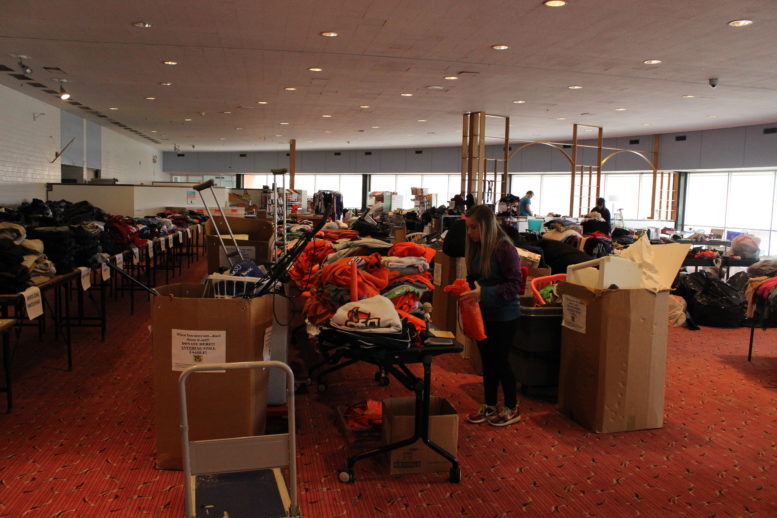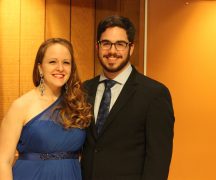By DAVID DUPONT
BG Independent News
The Harshman Community Room has everything needed to equip a college student, lots of everything needed.
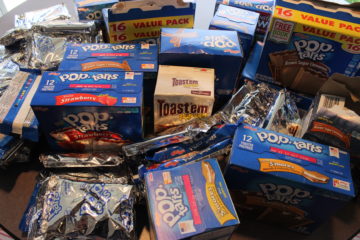 Books, planners, printer paper are here. Cardboard crates overflow with boxes of mac and cheese, ramen noodles and Pop Tarts of all varieties. Clothes, from coats to undies, suitable for all occasions from a session in a gym to a special date or a job interview, are piled and hung around the room. Falcon spirit wear gets its own stack. Want to see how you look? There’s about 30 mirrors.
Books, planners, printer paper are here. Cardboard crates overflow with boxes of mac and cheese, ramen noodles and Pop Tarts of all varieties. Clothes, from coats to undies, suitable for all occasions from a session in a gym to a special date or a job interview, are piled and hung around the room. Falcon spirit wear gets its own stack. Want to see how you look? There’s about 30 mirrors.
Mini-fridges and microwaves are stacked on a table, and a few computers, albeit of questionable operating status, are nearby. Off in one corner is the furniture, and shoes take up an entire room size space.
Welcome to the sorting operation for Bowling Green State University’s Move Out, Don’t Throw It Out project.
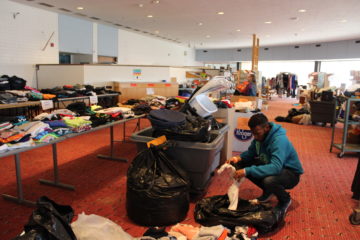 Now in its 15th year, the drive encourages students to donate whatever they don’t want that may be usable to the drive. Boxes are located throughout campus, in dorms, at convenience stores, in the student union. It’s a form of “passive community service,” Hennessy said. The organizers will try to find new homes for their castoff goods.
Now in its 15th year, the drive encourages students to donate whatever they don’t want that may be usable to the drive. Boxes are located throughout campus, in dorms, at convenience stores, in the student union. It’s a form of “passive community service,” Hennessy said. The organizers will try to find new homes for their castoff goods.
“Somebody’s future treasures,” said Torrance Vaughn, a student volunteer sorting through a bag of clothing. “Somebody will have a use for it.”
The idea is to promote reuse and waste reduction, said Nick Hennessy, director of the BGSU Office of Campus Sustainability. On Monday with the students gone, he and Carina Weed, the intern who organized the event, and a group of student volunteers, were sorting through what was left behind. Last year, Hennessy said, the drive collected almost nine tons of material, and he wasn’t sure if that included the food. All that otherwise most likely would have gone to the landfill. “I would like to think not, but I don’t know where else it would end up.”
He added: “What gets really overwhelming when you multiply that by every university. The landfills must just swell this time of year with all this stuff.”
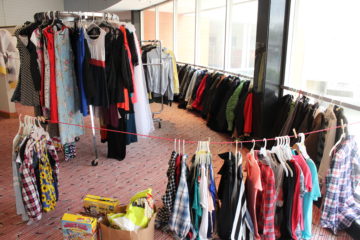 Already the tables groan with the plenty of hand-me-downs. All are carefully sorted. “We try to get as specific as possible because that helps with the final dispensation of it,” Hennessy said.
Already the tables groan with the plenty of hand-me-downs. All are carefully sorted. “We try to get as specific as possible because that helps with the final dispensation of it,” Hennessy said.
Some items are of questionable use. A half-full bottle of ketchup? A portfolio with resumes?
Charities such as the Cocoon Shelter will have a chance to go through and retrieve whatever personal care items they can use. “Food all goes directly to food pantries we’ve helped the out for more than a decade,” he said.
On May 24 and 25 from 9 a.m. to 3 p.m., a sale open to students, faculty and staff with valid identification will be held in the Harshman Community Room to sell off much of the rest. Details of the sale are still being set.
This is the second year of the sale. Last year, Hennessy said, it raised close to $3,000. That money is used to fund sustainability efforts on campus.
“I will say our prices were very, very reasonable,” he said. “I let my students decide what was right.” While the money benefits people and initiatives, he said, “it’s not intended to be a huge profit making venture.”
Some school supplies are just given away.
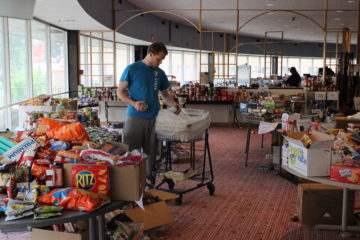 The overriding mission of the project is “attempting to educate people on reduce or waste reduction.” The project hopes to show that someone doesn’t need to buy a new lamp or mini-fridge, they can buy one used but still in good shape.
The overriding mission of the project is “attempting to educate people on reduce or waste reduction.” The project hopes to show that someone doesn’t need to buy a new lamp or mini-fridge, they can buy one used but still in good shape.
Weed said students setting up apartments in the summer are one customer base for the sale. Because of lack of storage, she said, it’s not feasible to hold the sale in late summer when students arrive for the fall semester.
Hennessy said he was surprised by people who would come to the sale, and run to specific area.
Weed said one woman was looking for North Face jackets.
What doesn’t sell will be donated to charities.
Weed was skeptical when she first looked at the space, and wondered if they needed it all. Now it’s full to all corners, and some bags still need to be emptied, and some boxes still need to be retrieved from dorms.
Hennessy said the project was inspired by a similar effort at Texas Tech. At first it was run by the Office of Residence Life where Hennessy then worked. Once the Office for Campus Sustainability was started, that seemed like a natural home for the project.
What still needs to be addressed is how to expand the efforts to off-campus housing. Students who live off-campus can bring in items. But “we don’t get many takers,” Hennessy said.
When the university was renting apartments to house students, a few experiments were tried. Boxes were located in lobbies, and a truck would visit at certain times to haul stuff away. But those haven’t continued.
The job is daunting. “That would be massive if it were to be successful,” Hennessy said. “It’s something that needs to be addressed someday.”
“It would require a partnership with apartment owners,” he said. He believes there may be some interest. “Maybe one day try to expand.”
For now some folks help themselves to what’s left behind at off-campus housing. “You see people looking for stuff by the dumpster,” Hennessy said “I want people to be safe, but I see why they do it. There’s a lot of good stuff that’s getting thrown away and they want to take advantage of that.”

